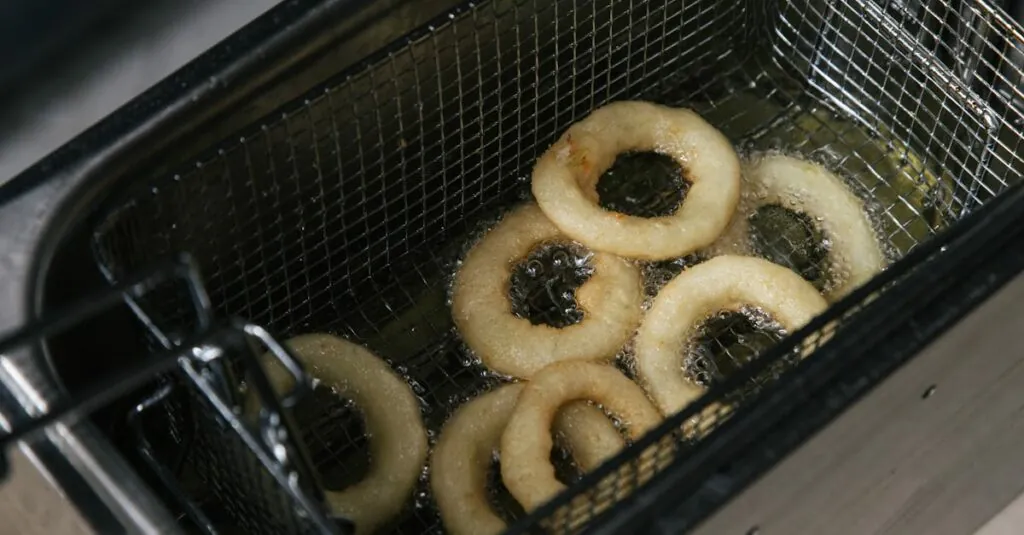Table of Contents
ToggleDeep frying isn’t just a cooking method; it’s a culinary adventure that transforms ordinary ingredients into crispy, golden delights. Imagine biting into a perfectly fried piece of chicken or a doughnut that practically melts in your mouth. It’s no wonder this technique has a special place in kitchens around the world, from backyard barbecues to gourmet restaurants.
Overview of Deep Frying
Deep frying transforms food by submerging it in hot oil, creating a crispy texture and rich flavor. This method remains popular across various cuisines.
Definition of Deep Frying
Deep frying involves cooking food by fully immersing it in hot oil, typically at temperatures ranging from 350°F to 375°F (175°C to 190°C). The heat from the oil quickly cooks the outer layer, forming a crispy crust, while sealing in moisture within. This technique results in delightful contrasts, including crispy exteriors and tender interiors. It’s vital to choose the right oil with a high smoke point, such as vegetable or peanut oil, to ensure optimal results.
Common Foods Deep Fried
Many beloved foods undergo deep frying to enhance their flavor and texture. Fried chicken stands out as a classic example, characterized by its crunchy coating. Doughnuts, whether glazed or filled, receive a golden brown finish through this method. French fries, a favorite side dish, derive their satisfying crispiness from immersion in hot oil. Fish and chips showcase another example, where fish fillets get perfectly battered and fried. Onion rings also gain their iconic crunch through deep frying, appealing to a wide range of taste preferences.
The Science Behind Deep Frying
Deep frying involves a complex interaction of heat and oil, resulting in flavorful dishes with appealing textures. Understanding the science helps appreciate this culinary technique.
Heat Transfer in Deep Frying
Heat transfer occurs through conduction and convection in deep frying. Hot oil surrounds the food, transferring heat rapidly to its surface. This immediate heat causes moisture to escape, forming a crispy crust. The high temperatures, typically between 350°F and 375°F (175°C to 190°C), create a Maillard reaction, enhancing flavor and color. Simultaneously, heat penetrates deeper, cooking the food’s interior. The combination of outer crispiness and inner tenderness distinguishes deep-fried items, making them popular treats.
Oil Types Used for Deep Frying
Selecting the right oil is critical for deep frying success. Oils with high smoke points, such as vegetable, peanut, and canola oil, withstand the intense heat without breaking down. Vegetable oil, commonly used, offers a neutral flavor that complements various foods. Peanut oil is favored for its nutty taste and stability at high temperatures. Canola oil provides a healthy option due to its low saturated fat content. Choosing the appropriate oil affects flavor, texture, and healthiness, ensuring the best results in fried dishes.
Benefits of Deep Frying
Deep frying offers several advantages that make it a preferred cooking method. The unique combination of flavor and texture creates an irresistible appeal in many dishes.
Flavor and Texture Enhancement
Deep frying enhances flavor and texture significantly. When food submerges in hot oil, a crispy outer layer forms while the inside remains moist and tender. This contrast elevates the overall eating experience. Fried foods often develop rich flavors due to the Maillard reaction, which occurs at high temperatures. Classic examples include fried chicken and doughnuts, where the crispy coating complements the soft interiors. These improvements make deep-fried options favorites in both casual and fine dining settings.
Quick Cooking Time
Quick cooking time represents another key benefit of deep frying. Submerging food in oil at temperatures between 350°F and 375°F cooks items rapidly. This efficiency retains moisture inside while achieving a perfect exterior. For instance, French fries cook in just a few minutes, resulting in a crispy texture and delicious flavor. High heat also reduces the risk of oil absorption, keeping the finished product less greasy. Busy kitchens and home cooks appreciate this fast method, making it suitable for various culinary needs.
Drawbacks of Deep Frying
Deep frying poses several drawbacks that warrant consideration.
Health Considerations
Deep frying contributes to health issues due to high fat content. Foods cooked through this method absorb significant quantities of oil, leading to increased calorie intake. Eating fried foods regularly correlates with a higher risk of conditions like obesity, heart disease, and high blood pressure. Additionally, the formation of harmful compounds, such as acrylamide, occurs in starchy foods when fried at high temperatures. These factors highlight the importance of moderation in enjoying deep-fried dishes, ensuring balance with healthier options.
Environmental Impact
Deep frying has a notable environmental impact. The large quantities of oil used contribute to waste and pollution. Disposing of used cooking oil can lead to soil and water contamination if not handled correctly. Furthermore, the energy consumption required for maintaining high cooking temperatures adds to a larger carbon footprint. Choosing sustainable oils and proper disposal methods can help alleviate some environmental concerns but doesn’t eliminate them entirely.
Tips for Successful Deep Frying
Deep frying requires careful attention to detail and proper equipment. The right approach enhances flavor and ensures safety in the kitchen.
Choosing the Right Equipment
Selecting the right frying equipment significantly affects the outcome. Using a deep fryer simplifies the process and offers temperature control. If a fryer isn’t available, a heavy, deep pot can work. Cast iron skillets or Dutch ovens also ensure even heat distribution. Use a thermometer to monitor oil temperature, ensuring it stays between 350°F and 375°F for best results. Investing in a spider or slotted spoon aids in safe food retrieval. Consider oil capacity, as too much food at once cools the oil and leads to greasy results.
Safety Precautions
Safety plays a critical role in deep frying. Always protect the work area with towels to catch spills and drips. Use long tongs or a frying basket to reduce the risk of burns. Wearing gloves and an apron minimizes contact with hot oil. Keep a lid nearby to smother flames in case of oil fires. It’s vital to maintain a safe distance from the hot oil, especially when adding food. Never leave the frying pot unattended, as overheating oil can lead to smoke or igniting.
Deep frying is a beloved cooking method that transforms ordinary ingredients into extraordinary dishes. Its ability to create a crispy exterior while keeping the interior moist is unmatched. While the technique offers delightful flavors and textures it’s essential to approach deep frying with awareness of health and environmental concerns.
Choosing the right oil and equipment can enhance the experience while ensuring safety in the kitchen. With proper techniques and moderation deep frying can remain a cherished culinary adventure that brings joy to any dining table. Whether enjoyed at home or in restaurants this method continues to captivate food lovers everywhere.




